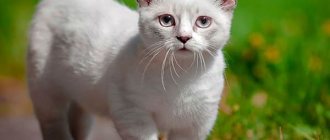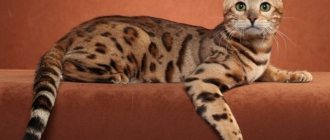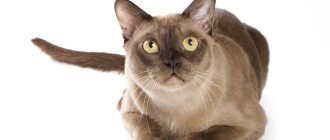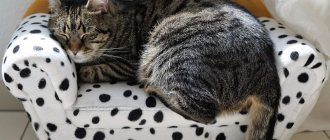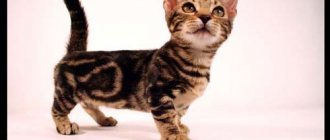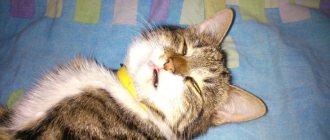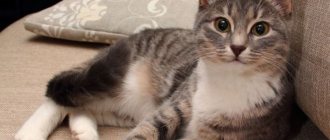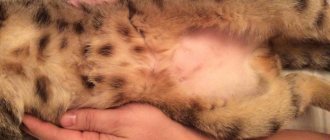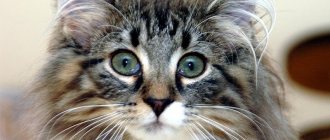The history of munchkins
Munchkins are charming short-legged cats.
In the 30s of the twentieth century, references to unusual short-legged cats periodically appeared in Europe. The Second World War, which soon broke out, almost completely erased this genetic line. In 1944, one of the British veterinarians reported observations of several generations of cats that were similar to ordinary domestic cats except for the parameters of the limbs. After the war, such animals were seen in the USA and USSR. In 1953, Soviet sources dubbed them "Stalingrad kangaroos", suggesting that the mutation occurred due to existence in harsh conditions.
The modern round of development of the Munchkin breed occurred in 1983, when teacher Sandra Hochenedel from Louisiana, returning home, noticed an unusual pregnant cat. The woman took pity on her and took her in, giving her the nickname Blackberry. Half of the kittens that were born also had short legs, which surprised Sandra. She decided to give an unusual pet to her friend Kay LaFrance. This is how the Blackbury and Toulouse cats became the ancestors of the modern breed.
Sandra and Kay managed to interest Dr. Solveig Pflueger, who served as a TICA judge, about munchkins. He examined the unusual cats and made an unequivocal verdict - the breed appeared naturally, thanks to changes in the recessive gene that regulates the length of the paws. Unlike dachshunds and other short animals, munchkins' short legs usually do not lead to back problems.
Munchkin kitten
The general public first learned about the breed at the TICA national show held at Madison Square Garden in 1991. Most viewers and experts were critical of the viability of munchkins, branding them living evidence of violations of the breeders' ethics. Despite lengthy disputes, by 1994 TICA managed to list the breed as developing. In the early 2000s, munchkins won the championship title and gained real popularity.
The breed is recognized by the associations TICA, AACE, UFO, SACC and WNCA. The FIF, CFA and Governing Council of the Cat Fancy societies refused to register munchkins, considering these cats to be genetically inferior. TICA resolved the issue democratically - only cats whose owners are able to confirm a monobreed pedigree in three or more generations are allowed to participate in the show. Munchkins got their unusual name in honor of the cheerful, friendly people from the book “The Wonderful Wizard of Oz.”
Cats with short legs
The most famous breeds of cats with short legs are Munchkin, Bambino, Napoleon, Lamkin, Kinkalow, Skookum. Each of them has its own characteristics of behavior and character. All animals have a friendly disposition and get along well with small children.
Bambino
Bambino cats
The breed arose as a result of crossing two other breeds: the Sphynx and the Munchkin. The first kitten from such parents appeared in 2005. He inherited two distinctive features from his dad and mom: short legs and lack of hair.
The cat has good physical characteristics, loves to frolic, is able to remember and perform simple tricks, and knows and loves its owner.
Separation from the owner negatively affects the bambino: the animals even refuse to eat. This factor must be taken into account when deciding to get a pet. Cats tolerate moving, travel, and new surroundings well and quickly adapt to new conditions.
The breed is expensive; the price of a hairless kitten starts from 35,000 rubles.
Napoleon
Cats of the Napoleon breed
Napoleon is the result of crossing a Munchkin with a Persian. In 2005, the International Cat Association recognized the new breed.
The cat has a round muzzle and large eyes, the muzzle is more like the muzzle of a fluffy Persian. The wool is very thick, its length and color can vary. Weight no more than 2 kg. Jumping and falling from heights are especially dangerous for Napoleons.
Pets are distinguished by their peaceful nature, are suitable for families where children are raised, and go into the arms of strangers.
Be sure to read:
Russian Blue cat: description of the breed and character, advantages of the breed
The price of a kitten depends on the pedigree, color and length of the paws, ranging from 30,000 to 80,000 rubles.
Lamkin
Cat of the Lambkin breed
Lambkin, or Lambkin (English: Lambkin Dwarf cat) is a dwarf breed with curly hair, recently bred in the USA. The Lemkin breed has no official recognition. The parents of the first lambkins were the Munchkin and the Selkilk Rex.
There are several nurseries for breeding purebred cats, all located in the USA and New Zealand. According to the clubs, there are no lambkin breeders in Russia.
A special feature of the breed is its curly coat, the color can vary, there are no standards. In the litter there are kittens with straight hair or curly hair, but with long legs.
Cats are funny and playful. They get along with children. They love to move and can climb heights.
Kittens are sold for an average of 15,000 rubles. Often, non-standard kittens from a litter of purebred cats are usually passed off as lambkins. When contacting a specialized nursery, the price will be several times higher. This is a very rare breed.
Munchkin
Munchkin cat
At the end of the last century, a US resident, Sandra, took in a stray cat, deciding that her legs were short because of the harsh living conditions. But Ezhevichka (that’s what the cat was called) gave birth to the same short-legged offspring. The breed achieved official recognition in 1991. Until now, the breed standard has not been fixed, but the description that a purebred animal must correspond to exists. This breed is involved in the development of new dwarf cat breeds.
The main feature of the Munchkin is its paws - they are short and straight. The color can be different, as well as the length of the coat. Among the representatives of the breed there are lop-eared individuals.
Munchkins are friendly creatures and get along well with people. Due to their short legs, they do not jump well in height. They become strongly attached to their owners.
The price of munchkins varies from 5,000 to 35,000 rubles.
Be sure to read:
European Shorthair (Celtic cat): description of the breed, character, kittens, where to buy
Kinkaloe
Kinkalow cat
The breed was bred in the USA by crossing a Machkin and a Curl. Kittens have short legs and curled ears. This breed is found mainly in America; it has not become widespread in Russia, although Kinkalows are officially recognized.
The breed also has a long tail. The animals have thick, shiny fur. Weight does not exceed 3 kg.
Cats become very attached to their owner and do not like to be left alone. They enjoy playing with children. Frisky and active animals.
The price is high due to the fact that the breed is rare - from 500 to 1000 euros. You can only buy it in the USA.
Skookum
Skookum cat
American citizen Roy Galusha developed a new dwarf breed by crossing a munchkin and a laper in 1996. Roy achieved official recognition of the breed 10 years later.
Outwardly, Skookum is similar to other cats of dwarf breeds, but the weight of the animal is larger: up to 4 kg. The coat is wavy, especially the fluffy collar area.
Skookums spend their time actively, love to play with their owners, but will not bother them. A distinctive feature is a quiet voice.
The price is high - from 800 to 3500 euros, it will not be possible to buy in Russia. Can be purchased in European countries.
Munchkin appearance
Munchkin
Munchkins are unique and cannot be confused with other cats due to their greatly shortened paws. With an average body size, the legs of these cats are 2-3 times smaller than those of other breeds. Despite this mutation, munchkins have retained a healthy spine, so they have a mobile, flexible, strong body. The average weight of cats ranges from 2.2 to 4 kilograms.
Munchkins are often crossed with other breeds, so they can differ in appearance and personality. The offspring are often long-legged. Such cats do not participate in shows, but can be used for the development of the breed, since the presence of two short-legged parents increases the mortality rate of kittens in the litter. Breeders are actively developing munchkins, so associations have not yet introduced strict standards.
Head
Proportional to the size of the body, has rounded contours, the shape of a modified wedge. The cheekbones are high and are usually more pronounced in cats than in cats. The muzzle is of medium length, the transition of the nose to the forehead is smooth. Some deflection of the bridge of the nose is allowed. The chin is small and firm.
Eyes
Munchkin looks out the window
Almond-shaped, medium to large in size. The rather wide set at a slight angle provides an open expression to the muzzle. Munchkins do not have a strict connection between eye color and coat color.
Ears
The ears are wide at the base and rounded at the tips. Sinks can be medium or large in size, located wide and high. The presence of tassels is permissible only in representatives of the breed with long hair.
Neck
Cats have larger, more muscular, dense necks than cats.
Body
The Munchkin's body is elongated and cannot be called compact. The back has a slight downward slope from the tail to the shoulders. The hips are firm, the chest is rounded. The bones are of medium size, the muscles are well developed. Males are usually larger than cats. Angled blades are allowed.
Munchkin and his toys
Legs
The limbs are short, located at the same distance in the direction of view from head to tail. The upper and lower parts of the front legs, as well as the thighs and lower parts of the hind legs, are equal in length. The hind limbs are often slightly longer than the forelimbs. Munchkins have three legs: regular, short, and very short (Rug hugger).
Paws
Red munchkin kitten
The Munchkin's paws are proportional to the body and have a rounded shape. Curvature outward or inward is not allowed.
Tail
The length of the tail and body is usually the same. The thickness is average, there is a rounded, somewhat narrowed tip. During movement, the tail comes to a vertical position. If there is long hair, this part of the body receives an abundant plume.
Wool
The coat is silky semi-long or velvety short, with medium undercoat.
Colors
Munchkins can have any coat color; bicolored individuals are often found.
Lifespan
Munchkins live 12-13 years, but with professional care they can live up to 16-20 years.
Possible disadvantages
Too short or long nose, protruding chest bone, round head and eyes, cow-type paws, stocky short body, curly hair.
Disqualification criteria
Deafness, amputated claws, cryptorchidism.
Disqualifying defects for exhibition
The presence of characteristic features of other breeds, saggy croup, excessively concave back.
Description of the Munchkin breed
The description of the Munchkin breed should begin with a consideration of the most unusual feature of these cats - their short legs. Munchkins' paws are several times shorter than those of an ordinary domestic cat. However, this does not prevent them from leading a full life and does not affect mobility. Otherwise, the appearance of munchkins is no different from other cats.
The Munchkin cat breed comes in long-haired and short-haired varieties. These cats have smooth, shiny and silky fur. It is very dense, with moderate undercoat and good protective properties. On the lower part of the body, the fur is longer than on other areas, and the fur collar is prominent in long-haired munchkins. Munchkin cats can come in a variety of colors and color combinations.
Munchkin cats have large expressive eyes, a round head, an elongated body, short legs and a long tail. The eye color of these cats is not related to color and can have different colors. The Munchkin's wide-set ears are medium in size. The hind legs of these cats are longer than the front ones. The munchkin's weight varies from 2 to 5 kg. Cats are bigger than cats. The average life expectancy of munchkins is 12 years.
The description of the Munchkin breed includes another unusual feature of these cats. Munchkins love to sit on their hind legs, maintaining an upright body position and hanging their short front legs over the sides. In this pose they look especially cute and are very reminiscent of kangaroos. Short-legged animals can remain in this position for quite a long time and often sit for hours in front of the window, watching what is happening on the street.
Photos of munchkins
Munchkin character
Munchkin on his hind legs
Munchkin looks at life realistically and does not complain about its trials, is confident in himself and his abilities, good-natured, and curious. People see these cats as slightly out of this world. It cannot be said that the character of munchkins is approximately the same, it depends on genes, so their types of behavior are different. But in general, these are lively animals with great sympathy for people.
Representatives of the breed love outdoor games; the short legs of munchkins do not prevent them from being quite nimble: they very quickly jump on low tables, chairs, and other furniture. And the owners’ favorite curtains are also easily attacked by them. Of course, they won’t be able to jump too high, but stealing something tasty from the kitchen table after first jumping on, for example, a stool is a piece of cake for them.
Munchkins are smart, very friendly, clean animals that quickly get used to new surroundings and people. They remain playful throughout their lives and are especially fond of children. Munchkins are extremely inquisitive, often “borrowing” and hiding small things to play with in moments of loneliness, so it is better to hide all valuable, fragile trinkets away. It is advisable to periodically look for such “treasuries”, since missing keys, socks, and pencils are usually found there.
Munchkins are distinguished by truly canine devotion to their owner, but they have their own character and are able to stand up for themselves. These cats easily tolerate travel and do not resist walks on a harness. An interesting feature of the breed is the ability to sit on its hind legs for a long time, surveying the surroundings. At the same time, the front legs hang funny along the body, which is why munchkins are often called “kangaroo cats.”
Who invented the munchkin
Dachshund cats are now increasingly called munchkins. Well, they really are similar. But a little less than a hundred years ago, when the first mentions of these strange animals with short legs had just appeared, the Germans usually called them... kangaroo cats.
Here it is, the famous munchkin pose - sitting on its hind legs
Curious cats want to know everything and see everything around them, but their small stature limits their view. Smart animals have found a way out of the situation - they simply sit on their hips, resting their tail on the floor for safety: I sit well, I look far away. This is the famous “Munchkin pose”, which all other, longer-legged cats cannot do.
The Munchkin can sit in a “column” for a very long time: he stretches his neck, dangles his small paws - at this moment he really looks like a kangaroo.
History of the breed
Amazing cats appeared in different European countries and gave birth to the same short-legged offspring, which gave felinologists the opportunity to regard this as a consequence of a mutation. Enthusiasts set about creating a new breed and, undoubtedly, would have achieved success along this path if it had not been interrupted by the Second World War. The predecessors of the breed were also in Russia under the then conventional name “Stalingrad kangaroo cats”.
Selection work was interrupted for several decades, but the short-legged cats categorically disagreed with this and decided to make themselves known again. This time - in the United States of America, in Louisiana. As often happens, it all started completely by accident. Even the exact date of the breed’s history is known - 1983.
A music teacher and just a kind woman named Sandra Hochenedel found a pregnant cat with unnaturally short legs under her old truck. Sandra attributed this circumstance to a difficult life, wanderings and illnesses; she took pity on the unfortunate animal and sheltered it in her car. Soon the black and white cat, named Blackberry, gave birth to offspring. To the surprise of the owner, the kittens also had short legs.
This is what the cat Ezhevichka, the ancestor of the munchkins, looked like
Experts have taken a specific interest in the unusual kittens. They found out the main thing: the stable mutation that the Blackberry cat passed on to its heirs, and subsequently its children, in no way harms their health. American felinologists have done a great job of creating a new breed, which, by the way, received a lot of criticism at first. But the incredible charm of the short-legged people won out. Already by the beginning of the 90s, the fashion for unusual cats broke out in Europe, and then in Japan.
They were called munchkins - in honor of the little fairy-tale people from the famous book “The Wizard of Oz” by the American children's writer Lyman Frank Baum. This story is better known to us as “The Wizard of the Emerald City” in a free retelling by Alexander Volkov. In the original, a hurricane transports the girl Dorothy, along with her dog Toto and the house, to the Land of the Munchkins - the land of short munchkins, where the events of the fairy tale unfold.
Long-haired munchkins were the first (in 1995) to receive official recognition - the International Association of Cat Fanciers approved the breed standard. And the “pioneer” of the breed in Russia was a cat named Mimi Mee Pocket Herkules, brought from South Africa in 2001.
Video: descendants of the cat Ezhevichka
Care and maintenance
Who is the most curious cat?
This breed is easy to maintain and does not require special care. Experts recommend following a few simple rules.
- Despite the sociable nature of cats, they love to “build nests” in order to feel protected while resting. Provide the munchkin with a basket, small sturdy box, or other house with soft bedding.
- Buy a deep tray, since clean pets actively bury waste and can litter around.
- It is enough to comb short-haired munchkins once a week, and 2 times a week for long-haired munchkins. The main thing is to prevent tangles from occurring.
- It is enough to bathe these cats once every 3-4 months with special shampoos.
- Changing claws is usually easy for munchkins, especially if there is a scratching post in the house. Once every 2-3 weeks it is worth checking the condition of the paws in order to help the pet if necessary.
- You should clean your ears not deeply and very carefully, about once a month.
- It is not advisable to let cats go for walks on their own, as a squat animal often looks like it is preparing to attack, which may be misunderstood by other pets or people. Due to the short legs, the munchkin can be injured.
- Munchkins should be fed in moderation because, despite their high mobility, they are prone to obesity. Provide frequent replacement of drinking water and adequate nutrition.
- By using special toothpastes once a month, you can successfully prevent the development of oral diseases in munchkins.
Om-Nom-nom
As for food, it is not recommended to feed your cat from a common table. Use specialized or separately prepared natural foods. These types of food should be alternated, but not mixed in one plate. Do not buy cheap food as it is similar to fast food for humans. Are you planning to cook food for your munchkin at home? Experts advise preparing your diet this way:
- 60% – raw or boiled meat (rabbit, beef, offal);
- 30% – boiled or raw vegetables;
- 10% – porridge.
Munchkins should not be treated to salty, sweet, fried, smoked, bean dishes, fish, or fatty meats (lamb, pork). An adult cat can be fed a couple of times a day, kittens - up to 6 times a day.
Breed Features
Munchkins leave few people indifferent. They are so unusual that the first impression of meeting them is usually either surprise or... pity. It may seem uncomfortable for them to walk, much less run. But nothing of the kind - the mutation has absolutely no effect on the health or mobility of these animals. Short-legged animals even find a lot of advantages in their special anatomy and are constantly in a great mood.
A mutation of this kind is by no means unique among domestic animals - on its basis such well-known breeds of dogs as the hunting dog (dachshund) and the shepherd dog (Welsh Corgi) have long been bred.
The munchkin and dachshund have short legs of a similar nature.
Anatomy and appearance
The main distinguishing feature of munchkins' appearance is, of course, their short legs - their legs can be two or even three times shorter than those of other breeds. And in almost everything else, these are ordinary cats, very diverse in color. The standard defines two types of hair for this breed - long and short; in long-haired cats, tassels on the tips of slightly rounded ears are acceptable. The body and neck are strong, well muscled, slightly elongated. The tail is not too long and thick; munchkins balance it very skillfully.
Munchkins are absolutely adorable
The Munchkin is a medium-sized cat, even the most well-fed of them will not weigh more than four to five kilograms. Accordingly, the height of these animals is small - up to 15 centimeters at the withers. The hind legs are slightly higher than the front ones, due to this, when running, munchkins touchingly wag their “fifth point”, like ferrets, and click their claws like hedgehogs. They move surprisingly fluidly, harmoniously and quickly, conquering the most unexpected places in the house for their games.
A tortoiseshell cat named Liliput was even included in the Guinness Book of Records for her small stature - in October 2013 she was recognized as the shortest domestic cat (13.34 centimeters at the withers); This American record holder comes from California.
The famous Lilliputian cat, listed in the Guinness Book of Records, was only 13.34 centimeters tall at the withers.
Character and behavior at home
The character of munchkins is beyond praise. It’s hard to even imagine a cat that is more positive and disposed towards its owner. These animals are self-sufficient and unobtrusive, but they are interested in people in the grandest sense - munchkins are attached to their adored owner not like cats, but like dogs; They train well and even train well, which is a rare quality for other breeds.
Ideal companion cats, they are easy-going and ready to accompany their owner on voyages around the world, joyfully accepting changes and without losing their always good mood.
Munchkin - a cat with an ideal character
They are intelligent, intelligent and quick-witted, they never lose heart and find things to do for themselves. They love toys very much - and not only play with them, but also... collect them. A remarkable property of munchkins is the complete absence of aggression and very high adaptability. Sociability and enviable patience allow them to easily find a common language with other pets and get along well with small children.
Table: pros and cons of the Munchkin breed
| Breed Features | Advantages | Flaws |
| Character | Friendly, patient, flexible, very balanced | Sometimes they are too inquisitive |
| Behavior | Calm, absolutely non-aggressive | He is guilty of hoarding - he makes hiding places for various small items. |
| Feeding | With a properly structured diet, you can feed both natural food and high-quality dry food. | Do not overfeed - munchkins are prone to obesity |
| Reproduction | Good playability | The selection of a pair for breeding should be carried out by specialists |
| Health | Strong immune system | Susceptibility to genetic diseases and lordosis - due to overeating |
Video: munchkin cat in the house
Munchkin health
Two Friends
The Munchkin is a young breed with an actively expanding gene pool, so its representatives rarely suffer from congenital diseases and have good immunity. Owners should know that such cats have some intolerance to plant foods, so their share in the diet should be small. Sometimes there are cases of congenital lordosis - excessive deflection of the spine in the area of the shoulder blades.
Munchkins may suffer from lordosis. This is a disease in which the muscles that support the spinal column are weakened and it moves into the chest cavity, putting pressure on the heart and lungs. A slight curvature will not cause problems, but it can be aggravated by previous injuries and obesity. Severe lordosis causes difficulty breathing and increases stress on the heart muscle, which can lead to illness. However, lordosis is a fairly rare disease. By the way, other cat breeds can also suffer from it.
Since the munchkin's short paws are a consequence of a natural genetic mutation, some kittens may have short paws, while others may have normal or long paws. If the gene responsible for short limbs is passed on to an embryo from both parents, it can be fatal.
How to choose a kitten
The rules for selecting munchkin kittens are standard: take active, clean babies aged 12 weeks or older with the necessary vaccinations. Contact only reputable kennels that offer registered animals. This will allow you to purchase a truly healthy kitten, without serious congenital defects. Munchkins have won the love of a wide audience, so real queues often line up for them. If you don’t care about a certain gender, color type, or coat length, you can get a kitten fairly quickly. You should not buy munchkins at bird markets or through private advertisements, tempted by the low price. This can result in long-term treatment of the animal or the acquisition of a non-viable individual.
Photos of munchkin kittens
How much does a munchkin cost?
The price of a Munchkin kitten in Russia ranges from 3 to 40 thousand rubles, depending on gender, color, coat length, and the specific breeder. It is customary to cross Munchkins only with healthy domestic cats of similar appearance or with each other. Hybrid kittens that have inherited characteristics of other breeds are not allowed to show and are therefore sold at a reduced price. They do not differ in character from their counterparts and sometimes look nicer than the show ones. Also, healthy pets with other appearance features that cause disqualification from competitions will cost less. This is a great opportunity to acquire a loyal four-legged friend inexpensively.
Care
Cats are easy to keep and do not require complex actions from the owner. To keep your pet healthy and beautiful, you need to follow the recommendations given.
Wool
Cats are characterized by high cleanliness, however, the owner must systematically carry out grooming, which includes two mandatory hygiene procedures:
- Bathing. Cats do not like to take baths, but they should be bathed at least once every three months. At the same time, using specially designed shampoos without a strong odor.
- Combing wool. Munchkins need to be brushed systematically to remove dead and matted hair. For cats with short hair, the procedure is carried out at least once a week, and long-haired pets need daily brushing.
Nutrition
It is important to stick to a predetermined feeding schedule to help avoid digestive problems. The frequency of feeding directly depends on the age of the pet:
- up to 3 months - 5 times a day;
- from 4 months to a year - 3 or 4 times;
- from 1 year - 2-3 times a day.
The diet must be of high quality and appropriate to the age of the animal. The basis of cat nutrition is lean meat, which is combined with vegetables and grains. Before serving the meat, it is boiled or scalded with boiling water. The cat is provided with access to fresh water. Ready-made commercial food is best given to adult munchkins.
Walking your pet
Due to their compact size, Munchkins are suitable for keeping in apartments and country houses. They, like other cats, in addition to living quarters, are drawn to explore the surrounding nature, walk on green grass and run after birds.
For this purpose, in order to avoid dangerous situations, the owner walks the pet using a special harness. If the territory of a country house is fenced, then the cat is allowed to explore the yard without a leash.
Munchkin cats easily tolerate traveling , so the owner can not part with his pet, but take it with him on a trip out of town or on vacation.
